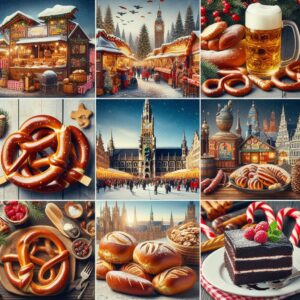German Holidays and Their Culinary Traditions
Germany is a land of vibrant traditions, where each holiday brings its own set of rituals, flavors, and celebrations. From hearty feasts to sweet treats, let’s explore how Germans commemorate special occasions throughout the year.

German holidays culinary traditions
Explore the flavors of Germany through its festive traditions! From Easter’s sweet Osterzopf to Oktoberfest’s hearty Hendl, discover the culinary delights that unite Germans in celebration. Immerse yourself in rich cultural heritage and savor the vibrant dishes of each holiday.
1. Karneval (Fasching)
Date: February/March (before Lent)
Traditions:
- Karnevalsumzüge: Colorful parades with elaborate costumes and festive floats.
- Kamelle: Bonbons thrown into the crowd during the parades.
Culinary Highlights:
- Berliner: Filled doughnuts, a must-have during Karneval.
- Kartoffelsuppe: Hearty potato soup or Erbsensuppe (pea soup) warms up the cold Karneval days.
2. Easter (Ostern)
Date: April (varies based on the lunar calendar)
Traditions:
- Easter Bunny (Osterhase): Children eagerly await the arrival of the Easter bunny, who hides colorful eggs in gardens and homes.
- Easter Bonfires (Osterfeuer): These symbolize the end of winter and the arrival of spring.
Culinary Delights:
- Osterzopf: A braided sweet bread, often enjoyed for breakfast.
- Osterlamm: A lamb-shaped cake representing Christ as the sacrificial lamb.
- Grüner Spargel: Green asparagus, in season during Easter, features prominently in dishes.
3. Pfingsten (Pentecost)
Date: 50 days after Easter (May/June)
Traditions:
- Pfingstbrunnen: Decorated wells and fountains adorned with flowers and ribbons.
- Pfingstkuchen: Sweet cakes enjoyed during this festive time.
Culinary Highlights:
- Spargel: Asparagus, whether green or white, takes center stage.
- Eierlikörkuchen: Egg liqueur cake adds a delightful touch.
4. Oktoberfest
Date: Late September to early October
Bavarian Delights:
- Hendl: Roast chicken with crispy skin, served with a soft pretzel (Brezn).
- Weißwurst: White sausages paired with sweet mustard.
Regional Variations:
- North Germany:
- Grünkohl mit Pinkel: Kale with smoked sausage, a winter favorite.
- Fischbrötchen: Fish sandwiches by the sea.
- South Germany:
- Schupfnudeln: Potato noodles with sauerkraut.
- Zwetschgendatschi: Plum cake, especially in Bavaria.
5. Christmas (Weihnachten)
Weihnachten is a magical time in Germany, marked by twinkling lights, festive markets, and heartwarming traditions. Here’s how Germans celebrate Christmas:
Advent Season:
- The Advent calendar is a cherished tradition. Each day leading up to Christmas, children open a numbered door to reveal a small surprise or treat.
- Advent wreaths with four candles are lit on Sundays. Families gather around, sing carols, and enjoy cozy evenings.
Christmas Eve (Heiligabend):
- Weihnachtsbaum (Christmas tree) is decorated with ornaments, candles, and tinsel.
- Families attend Christmette (midnight Mass) to celebrate the birth of Jesus.
- The festive meal on Christmas Eve often includes:
- Gänsebraten (roast goose) or Ente (duck) with crispy skin and rich gravy.
- Rotkohl (red cabbage) and Kartoffelklöße (potato dumplings).
- For dessert, Stollen (fruitcake) or Lebkuchen (gingerbread cookies).
Whether it’s the joy of Christmas, Easter, the exuberance of Karneval, the serenity of Pfingsten, or the lively Oktoberfest, German cuisine unites people in celebration. So, raise your glass and savor these culinary delights as you immerse yourself in Germany’s rich traditions!
Note: For more culinary tradition, visit GermanBuy.net and discover authentic German products.

